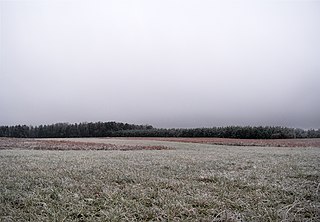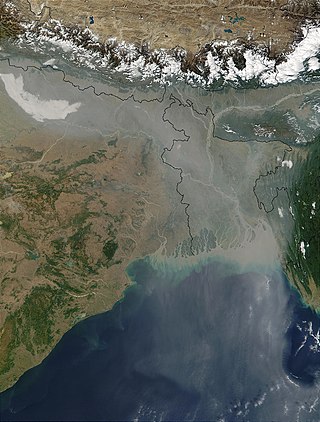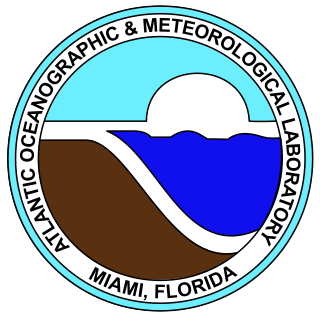Related Research Articles

Stratus clouds are low-level clouds characterized by horizontal layering with a uniform base, as opposed to convective or cumuliform clouds formed by rising thermals. The term stratus describes flat, hazy, featureless clouds at low altitudes varying in color from dark gray to nearly white. The word stratus comes from the Latin prefix strato-, meaning "layer". Stratus clouds may produce a light drizzle or a small amount of snow. These clouds are essentially above-ground fog formed either through the lifting of morning fog or through cold air moving at low altitudes. Some call these clouds "high fog" for their fog-like form.
The Carl-Gustaf Rossby Research Medal is the highest award for atmospheric science of the American Meteorological Society. It is presented to individual scientists, who receive a medal. Named in honor of meteorology and oceanography pioneer Carl-Gustaf Rossby, who was also its second (1953) recipient.

Cloud condensation nuclei (CCNs), also known as cloud seeds, are small particles typically 0.2 µm, or one hundredth the size of a cloud droplet. CCNs are a unique subset of aerosols in the atmosphere on which water vapour condenses. This can affect the radiative properties of clouds and the overall atmosphere. Water vapour requires a non-gaseous surface to make the transition to a liquid; this process is called condensation.
The Rosenstiel School of Marine, Atmospheric, and Earth Science is the University of Miami's academic and research institution for the study of oceanography, atmospheric, and earth sciences.

Drizzle is a light precipitation which consists of liquid water drops that are smaller than those of rain – generally smaller than 0.5 mm (0.02 in) in diameter. Drizzle is normally produced by low stratiform clouds and stratocumulus clouds. Precipitation rates from drizzle are on the order of a millimetre (0.04 in) per day or less at the ground. Owing to the small size of drizzle drops, under many circumstances drizzle largely evaporates before reaching the surface, and so may be undetected by observers on the ground. The METAR code for drizzle is DZ and for freezing drizzle is FZDZ.
This is a list of meteorology topics. The terms relate to meteorology, the interdisciplinary scientific study of the atmosphere that focuses on weather processes and forecasting.

The Atlantic Oceanographic and Meteorological Laboratory (AOML), a federal research laboratory, is part of the National Oceanic and Atmospheric Administration's (NOAA) Office of Oceanic and Atmospheric Research (OAR), located in Miami in the United States. AOML's research spans tropical cyclone and hurricanes, coastal ecosystems, oceans and human health, climate studies, global carbon systems, and ocean observations. It is one of seven NOAA Research Laboratories (RLs).

Entrainment is a phenomenon of the atmosphere which occurs when a turbulent flow captures a non-turbulent flow. It is typically used to refer to the capture of a wind flow of high moisture content, or in the case of tropical cyclones, the capture of drier air.

Marine cloud brightening also known as marine cloud seeding and marine cloud engineering is a proposed solar radiation management climate engineering technique that would make clouds brighter, reflecting a small fraction of incoming sunlight back into space in order to offset anthropogenic global warming. Along with stratospheric aerosol injection, it is one of the two solar radiation management methods that may most feasibly have a substantial climate impact. The intention is that increasing the Earth's albedo, in combination with greenhouse gas emissions reduction, carbon dioxide removal, and adaptation, would reduce climate change and its risks to people and the environment. If implemented, the cooling effect is expected to be felt rapidly and to be reversible on fairly short time scales. However, technical barriers remain to large-scale marine cloud brightening. There are also risks with such modification of complex climate systems.
Ground-based, flight-based, or satellite-based remote sensing instruments can be used to measure properties of the planetary boundary layer, including boundary layer height, aerosols and clouds. Satellite remote sensing of the atmosphere has the advantage of being able to provide global coverage of atmospheric planetary boundary layer properties while simultaneously providing relatively high temporal sampling rates. Advancements in satellite remote sensing have provided greater vertical resolution which enables higher accuracy for planetary boundary layer measurements.
The Jule G. Charney Award is the American Meteorological Society's award granted to "individuals in recognition of highly significant research or development achievement in the atmospheric or hydrologic sciences". The prize was originally known as the Second Half Century Award, and first awarded to mark to fiftieth anniversary of the society.
Robert Jay Charlson was an American atmospheric scientist, climate scientist, pioneer in the fields of climate forcing and climate change, and coauthor of the CLAW hypothesis.Charlson is known for his research in atmospheric chemistry, aerosol physics, aerosol/cloud/climate interaction, aerosol and cloud instrumentation.
Amy C. Clement is an atmospheric and marine scientist studying and modeling global climate change at the University of Miami's Rosenstiel School of Marine and Atmospheric Science.
Sonia Maria Kreidenweis is an American Professor of Atmospheric Sciences at Colorado State University. Her research considers aerosols and their impact on weather and the climate. She has previously served as President of the American Association for Aerosol Research and was a board member of the American Meteorological Society. She was elected a Fellow of the American Geophysical Union in 2019.

Julia Yvonne Schmale is a German environmental scientist. She is a specialist in the micro-physical makeup of the atmosphere, in particular aerosols and their interaction with clouds. She is a professor at EPFL and the head of the Extreme Environments Research Laboratory (EERL). She is a participant in the Multidisciplinary drifting Observatory for the Study of Arctic Climate (MOSAiC) expeditions.
Marcia Baker is a retired professor known for her research on cloud physics which informs global climate models and defines the processes leading to the formation of lightning from clouds.
Patricia K. Quinn is a atmospheric chemist working at the National Oceanic and Atmospheric Agency's Pacific Marine Environmental Lab. She is known for her work on the impact of atmospheric aerosol particles on air quality and climate.

Ulrike Lohmann is a climate researcher and professor for atmospheric physics at the ETH Zurich. She is known for her research on aerosol particles in clouds.
Glenn Edmond Shaw is an American scientist specializing in atmospheric physics, especially relating to global climate change and long-range transport of aerosol material. He is Emeritus Professor of Physics and Atmospheric Science at the University of Alaska Fairbanks and a member of the scientific staff of the Geophysical Institute. He conducted research on global atmospheric transport of aerosols and feedback of biogenic aerosols on global climate. He and Kenneth Rahn did research on the sources and climatic effect of Arctic haze. He did pioneering work on the scientific concept of climate homeostasis through the sulfur cycle and atmospheric aerosol.

Krzysztof Edward Haman is a Polish atmospheric physicist, professor at the University of Warsaw, and member of the Polish Academy of Sciences.
References
- 1 2 3 "ASR - Atmospheric System Research". asr.science.energy.gov. Retrieved 2024-02-20.
- 1 2 3 4 5 6 7 8 9 10 11 12 13 14 "User Executive Committee". ARM Research Facility. November 2022. Retrieved 2024-02-20.
 This article incorporates text from this source, which is in the public domain .
This article incorporates text from this source, which is in the public domain . - ↑ "Paquita Zuidema". people.miami.edu. Retrieved 2024-02-20.
- ↑ Udel, Diana (2024-01-29). "University of Miami professor elected Fellow of the American Meteorological Society". news.miami.edu. Retrieved 2024-02-20.